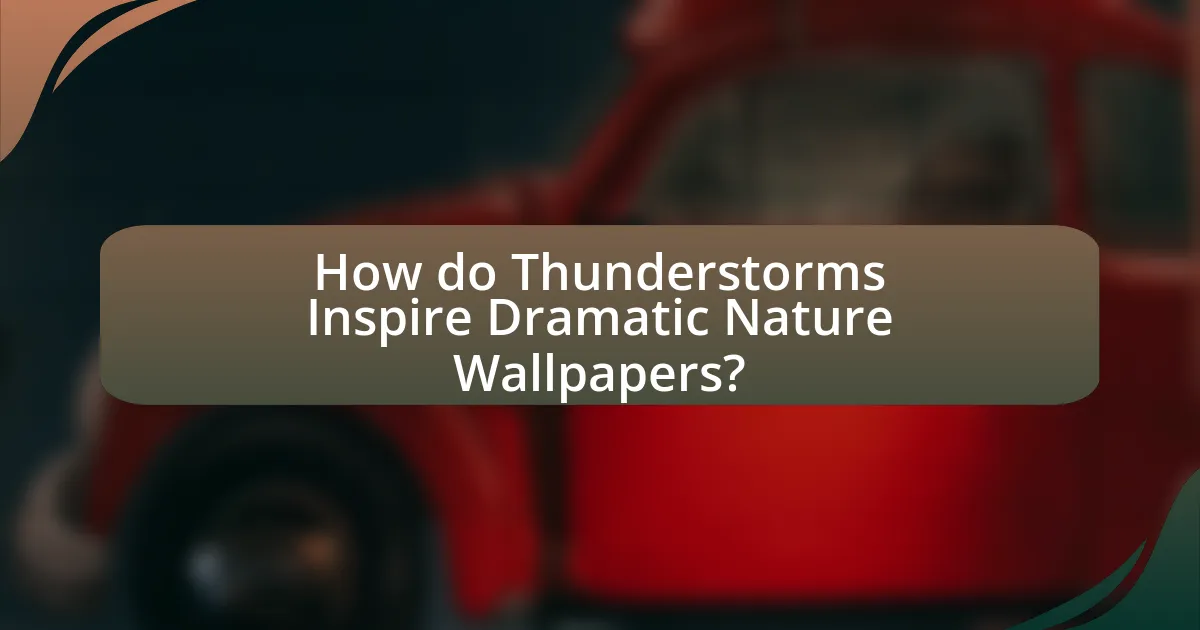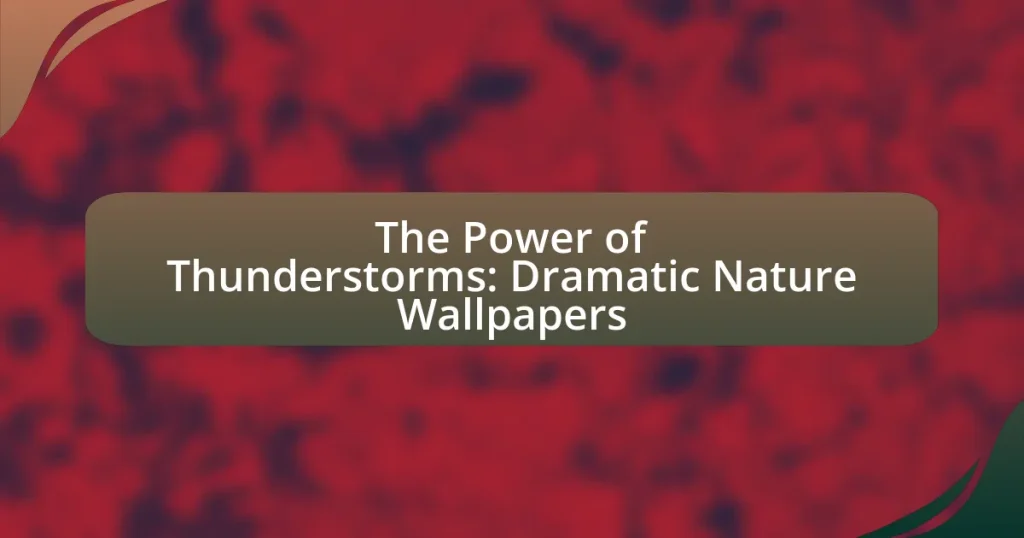Thunderstorms are complex meteorological phenomena characterized by lightning, thunder, heavy rain, and strong winds, forming under specific atmospheric conditions. This article explores the formation, lifecycle, and types of thunderstorms, including single-cell, multi-cell, and supercell storms, while highlighting their visual and auditory elements. Additionally, it examines how thunderstorms inspire dramatic nature wallpapers, discussing the emotional responses they evoke and the techniques used in capturing their imagery. The article also provides best practices for selecting and using thunderstorm wallpapers in personal and professional spaces, ensuring high-quality visual experiences.

What are Thunderstorms and Their Characteristics?
Thunderstorms are meteorological phenomena characterized by the presence of lightning, thunder, heavy rain, and often strong winds. These storms typically form when warm, moist air rises and cools, leading to the condensation of water vapor and the development of cumulonimbus clouds. The characteristics of thunderstorms include intense precipitation, potential hail, and the occurrence of severe weather events such as tornadoes. According to the National Weather Service, thunderstorms can produce wind gusts exceeding 58 miles per hour and can lead to flash flooding, making them significant weather events that require monitoring and preparedness.
How do thunderstorms form?
Thunderstorms form when warm, moist air rises and cools, leading to condensation and the development of cumulonimbus clouds. This process typically occurs when a cold front meets a warm front, causing the warm air to be forced upward. As the air rises, it cools and water vapor condenses into droplets, releasing latent heat, which further fuels the storm. The National Weather Service notes that the combination of moisture, instability, and lift is essential for thunderstorm formation, with conditions often leading to severe weather phenomena such as lightning, heavy rain, and hail.
What meteorological conditions are necessary for thunderstorm development?
Thunderstorm development requires three key meteorological conditions: moisture in the atmosphere, instability, and a lifting mechanism. Moisture provides the necessary humidity for cloud formation, while instability allows warm air to rise rapidly, creating convection. A lifting mechanism, such as a cold front or terrain, initiates the upward movement of air. These conditions are essential for the formation of cumulonimbus clouds, which are responsible for thunderstorms.
What stages do thunderstorms go through during their lifecycle?
Thunderstorms go through three main stages during their lifecycle: the cumulus stage, the mature stage, and the dissipating stage. In the cumulus stage, warm, moist air rises and cools, forming cumulus clouds. The mature stage is characterized by the development of heavy rain, thunder, and lightning, as well as the potential for severe weather phenomena like hail and tornadoes. Finally, in the dissipating stage, the storm weakens as the downdrafts dominate, leading to a decrease in precipitation and cloud formation. This lifecycle is supported by meteorological studies that outline the processes involved in thunderstorm development and decay.
What are the different types of thunderstorms?
The different types of thunderstorms include single-cell, multi-cell, and supercell thunderstorms. Single-cell thunderstorms are typically short-lived and form in a stable atmosphere, often producing brief rain and lightning. Multi-cell thunderstorms consist of a cluster of cells that can produce severe weather, including heavy rain and hail, due to their organized structure. Supercell thunderstorms are the most severe type, characterized by a rotating updraft, and are capable of producing tornadoes, large hail, and intense rainfall. These classifications are based on the storm’s structure and behavior, which directly influence the severity of the weather phenomena they produce.
How do single-cell thunderstorms differ from multi-cell thunderstorms?
Single-cell thunderstorms are isolated storms that typically last for a short duration and are characterized by a single updraft, while multi-cell thunderstorms consist of multiple cells that can develop simultaneously and persist longer due to the presence of multiple updrafts and downdrafts. Single-cell thunderstorms, also known as pulse storms, usually produce brief heavy rain and may lead to localized severe weather, whereas multi-cell thunderstorms can generate more widespread severe weather phenomena, including hail, strong winds, and tornadoes, due to their organized structure and ability to sustain themselves over time.
What are supercell thunderstorms and why are they significant?
Supercell thunderstorms are a type of severe thunderstorm characterized by a rotating updraft called a mesocyclone. These storms are significant because they are capable of producing extreme weather phenomena, including large hail, damaging winds, and tornadoes. Research indicates that supercells account for the majority of severe weather events in the United States, with the National Weather Service noting that they are responsible for approximately 75% of tornadoes. Their unique structure and longevity make them a focal point for meteorological studies and severe weather forecasting.
What are the visual and auditory elements of thunderstorms?
The visual elements of thunderstorms include dark, ominous clouds, often cumulonimbus in shape, which can produce vivid lightning strikes. These clouds can appear in various shades of gray and black, creating a dramatic contrast against the sky. The auditory elements consist primarily of thunder, which is the sound produced by the rapid expansion of air heated by lightning. Thunder can vary in intensity, ranging from a low rumble to a sharp crack, depending on the distance from the observer and the nature of the storm. The combination of these visual and auditory elements creates a powerful and awe-inspiring natural phenomenon.
How do lightning and thunder contribute to the overall experience of a thunderstorm?
Lightning and thunder significantly enhance the overall experience of a thunderstorm by providing visual and auditory elements that evoke strong emotional responses. Lightning illuminates the sky with bright flashes, creating dramatic contrasts and highlighting the storm’s intensity, while thunder produces deep, resonant sounds that can instill awe and fear. Studies show that the combination of these phenomena can trigger adrenaline responses in humans, making thunderstorms memorable and impactful experiences. The visual spectacle of lightning, which can reach temperatures of around 30,000 Kelvin, and the sound of thunder, which travels at approximately 1,125 feet per second, together create a powerful sensory experience that defines the nature of thunderstorms.
What role do clouds play in the dramatic visuals of thunderstorms?
Clouds are essential in creating the dramatic visuals of thunderstorms by forming towering structures that indicate intense atmospheric activity. These clouds, particularly cumulonimbus clouds, develop vertically and can reach heights of up to 60,000 feet, resulting in striking visual contrasts against the sky. The dark, dense appearance of these clouds, combined with lightning and precipitation, enhances the overall spectacle of thunderstorms, making them visually captivating. Studies show that the presence of these clouds can lead to vivid lightning displays, which further amplify the dramatic effect, as seen in various meteorological observations.

How do Thunderstorms Inspire Dramatic Nature Wallpapers?
Thunderstorms inspire dramatic nature wallpapers by showcasing the intense beauty and raw power of nature. The striking contrasts of dark storm clouds, vivid lightning, and the dynamic movement of wind create visually captivating scenes that evoke strong emotions. These elements are often captured in high-resolution images, emphasizing the dramatic interplay of light and shadow, which enhances the overall aesthetic appeal. The phenomenon of thunderstorms, characterized by their sudden onset and dramatic atmospheric changes, provides a rich source of inspiration for artists and photographers, leading to wallpapers that reflect both the awe and ferocity of nature.
What makes thunderstorms a popular subject for nature wallpapers?
Thunderstorms are a popular subject for nature wallpapers due to their dramatic visual impact and emotional resonance. The striking contrast of dark storm clouds against bright lightning and vibrant landscapes creates captivating imagery that draws viewers in. Additionally, thunderstorms evoke a sense of awe and power, appealing to those who appreciate the raw forces of nature. Studies show that images of thunderstorms can elicit feelings of excitement and wonder, making them ideal for wallpaper use. The combination of beauty and intensity in thunderstorm imagery captures the essence of nature’s unpredictability, further enhancing their popularity in digital art and photography.
How do the colors and contrasts in thunderstorm images enhance their appeal?
The colors and contrasts in thunderstorm images enhance their appeal by creating a striking visual impact that captures attention. The deep blues and grays of storm clouds juxtaposed with bright flashes of lightning and vivid hues of sunset can evoke strong emotions and a sense of drama. Research indicates that high contrast in images can lead to increased viewer engagement, as it draws the eye and emphasizes the dynamic nature of the scene. For example, studies in visual perception show that contrasting colors can enhance the perception of depth and movement, making thunderstorm images more captivating.
What emotions do thunderstorm wallpapers evoke in viewers?
Thunderstorm wallpapers evoke a range of emotions in viewers, primarily feelings of awe, tranquility, and sometimes fear. The dramatic visuals of thunderstorms can inspire awe due to their powerful and majestic nature, showcasing the raw force of the elements. Additionally, the calming effect of rain and the rhythmic sound of thunder can create a sense of tranquility, allowing viewers to feel relaxed and reflective. Conversely, the intensity of a thunderstorm can also evoke fear or anxiety, particularly in individuals who associate storms with danger or past traumatic experiences. Research indicates that natural imagery, including thunderstorms, can significantly impact emotional responses, as seen in studies on environmental psychology that highlight the connection between nature and human emotions.
What techniques are used in capturing thunderstorm images?
Techniques used in capturing thunderstorm images include long exposure photography, high dynamic range imaging, and the use of specialized equipment like tripods and remote triggers. Long exposure photography allows for the capture of lightning strikes by using slower shutter speeds, which can reveal the intricate details of the storm. High dynamic range imaging combines multiple exposures to capture the wide range of light present during a thunderstorm, ensuring both bright and dark areas are well represented. Additionally, using tripods stabilizes the camera for clearer images, while remote triggers prevent camera shake during the shot. These techniques enhance the visual impact of thunderstorm images, making them more dramatic and captivating.
How do photographers prepare for capturing thunderstorms?
Photographers prepare for capturing thunderstorms by closely monitoring weather forecasts and storm patterns to identify optimal conditions. They utilize tools such as radar apps and weather websites to track storm development and movement, ensuring they are in the right location at the right time. Additionally, photographers often scout locations in advance to find vantage points that offer dramatic compositions, while also considering safety measures, such as staying away from lightning-prone areas. This preparation is crucial, as studies show that the best thunderstorm photography occurs during specific atmospheric conditions, such as when warm, moist air meets cooler air, creating dynamic cloud formations and lighting opportunities.
What equipment is essential for photographing thunderstorms effectively?
To photograph thunderstorms effectively, essential equipment includes a DSLR or mirrorless camera, a sturdy tripod, and a wide-angle lens. A DSLR or mirrorless camera allows for manual settings to control exposure and shutter speed, which is crucial for capturing lightning. A sturdy tripod stabilizes the camera during long exposures, preventing blurriness. A wide-angle lens captures expansive skies and dramatic cloud formations, enhancing the overall composition. These tools are commonly used by photographers to achieve high-quality images of thunderstorms, as they provide the necessary control and stability to capture fleeting moments of nature’s power.

What are the Best Practices for Using Thunderstorm Wallpapers?
The best practices for using thunderstorm wallpapers include selecting high-resolution images to ensure clarity and detail, as well as considering the color scheme to match the overall aesthetic of the space. High-resolution images, typically 1920×1080 pixels or higher, provide a visually striking experience, enhancing the dramatic effect of thunderstorms. Additionally, choosing wallpapers with colors that complement existing decor can create a cohesive look, making the space feel harmonious. It is also advisable to use wallpapers in areas where they can be appreciated, such as living rooms or offices, rather than in overly busy spaces where they may be overlooked.
How can thunderstorm wallpapers enhance personal or professional spaces?
Thunderstorm wallpapers can enhance personal or professional spaces by creating a dramatic and immersive atmosphere that evokes emotions and stimulates creativity. The visual impact of thunderstorm imagery, characterized by dynamic clouds and striking lightning, can transform a mundane environment into one that inspires awe and contemplation. Research indicates that nature-themed decor, including storm imagery, can reduce stress and improve focus, making it particularly beneficial in workspaces. For instance, a study published in the Journal of Environmental Psychology found that exposure to natural scenes can enhance cognitive performance and emotional well-being. Thus, incorporating thunderstorm wallpapers can effectively elevate the aesthetic and psychological quality of both personal and professional environments.
What considerations should be made when selecting a thunderstorm wallpaper for a room?
When selecting a thunderstorm wallpaper for a room, consider the color scheme and mood it will create. Thunderstorm wallpapers often feature dark, dramatic colors that can evoke a sense of calm or intensity, depending on the design. Additionally, assess the size of the room; larger patterns may overwhelm small spaces, while smaller designs can enhance intimacy. The material of the wallpaper is also crucial; vinyl options are durable and easy to clean, making them suitable for high-traffic areas. Finally, ensure the wallpaper complements existing decor and furniture to maintain a cohesive aesthetic.
How can thunderstorm wallpapers be used in digital formats, such as screensavers or backgrounds?
Thunderstorm wallpapers can be effectively used in digital formats like screensavers or backgrounds by enhancing visual appeal and creating an immersive atmosphere. These wallpapers capture the dramatic essence of thunderstorms, showcasing vivid lightning strikes and dark, swirling clouds, which can evoke emotions and set a specific mood on devices. For instance, using a thunderstorm wallpaper as a screensaver can provide a dynamic visual experience, as the changing images can simulate the feeling of being in a storm, thus engaging viewers. Additionally, these wallpapers can be customized to fit various screen resolutions, ensuring optimal display quality across different devices.
What are some tips for finding high-quality thunderstorm wallpapers?
To find high-quality thunderstorm wallpapers, utilize reputable websites that specialize in high-resolution images, such as Unsplash, Pexels, or Shutterstock. These platforms offer a wide selection of professionally captured thunderstorm images, ensuring clarity and detail. Additionally, filter search results by resolution, opting for images that are at least 1920×1080 pixels to guarantee quality on various screen sizes. Checking user reviews and ratings can also help identify the most visually appealing options.
Where can one find reputable sources for downloading thunderstorm wallpapers?
Reputable sources for downloading thunderstorm wallpapers include websites like Unsplash, Pexels, and Pixabay. These platforms offer high-quality, royalty-free images contributed by professional photographers and are widely recognized for their extensive collections. Unsplash, for instance, features a dedicated section for nature photography, including thunderstorms, ensuring users can find visually stunning wallpapers without copyright concerns. Pexels and Pixabay similarly provide a vast array of thunderstorm images, all available for free download and use.
What should users look for to ensure the wallpapers are of high resolution and quality?
Users should look for wallpapers that have a resolution of at least 1920×1080 pixels to ensure high quality. This resolution is considered Full HD and provides clarity and detail suitable for most screens. Additionally, users should check for images that are labeled as “high resolution” or “4K” to guarantee superior quality, as these terms indicate a higher pixel density. Furthermore, users can verify the source of the wallpaper; reputable websites often provide images that meet quality standards, ensuring that the wallpapers are not only visually appealing but also technically sound.
